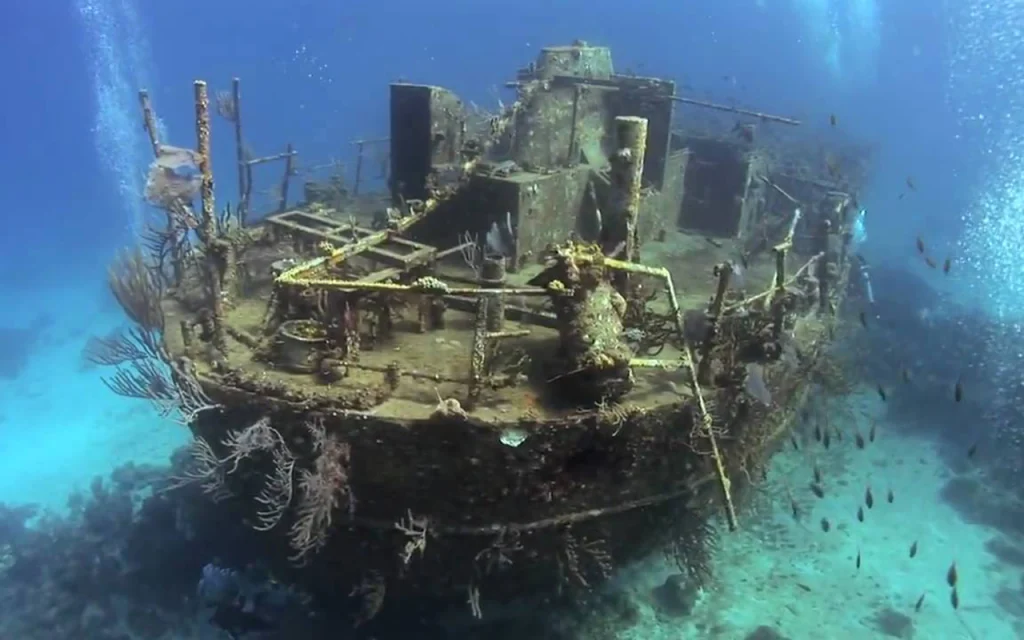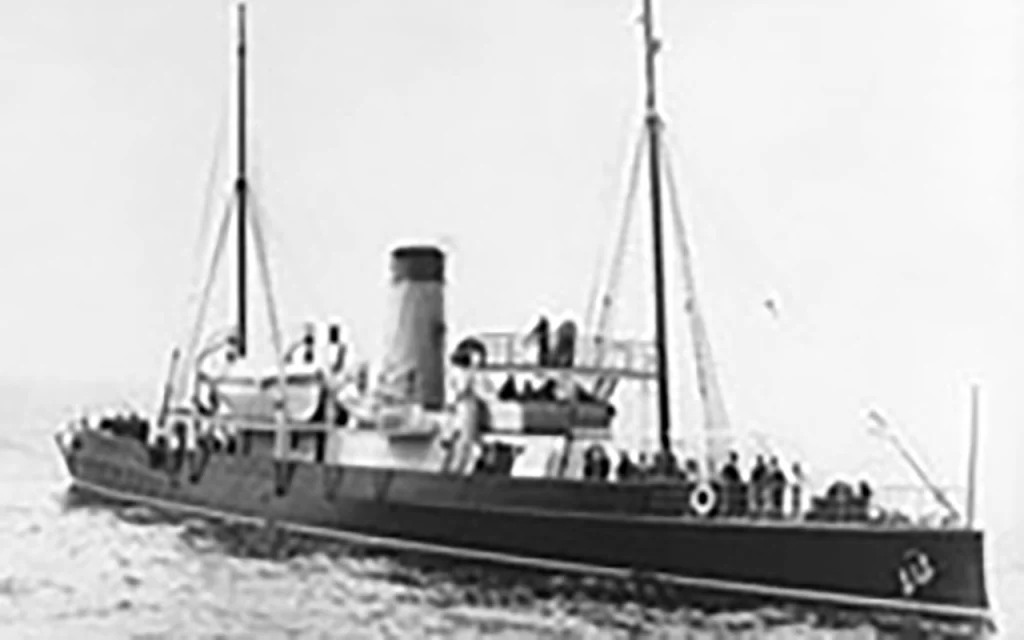Table of Contents

The Queen of Nassau’s location makes it a challenging dive site, suitable for technical divers due to its depth. The wreck was discovered in 2001 by recreational divers, and its location has since been documented by researchers from the Florida Keys National Marine Sanctuary.
Article at a Glance
- Location: 3 miles off Alligator Light, Florida Keys (24° 50.5′ N, 80° 37.5′ W)
- Depth: 230 feet (70 meters), considered a technical dive
- History: Built in 1904 as CGS Canada, served in WWI, renamed Queen of Nassau in 1924
- Sinking: July 2, 1926, while en route from Miami to Tampa
- Wreck Features: Relatively intact structure, visible ram bow, triple expansion engines
- Marine Life: Home to large fish, sharks, and coral growth
- Diving Requirements: Technical diving certification, specialized equipment, and experienced guide
Queen of Nassau Shipwreck Location Coordinates and Depth
Depth
The wreck lies at a depth of approximately 230 feet (70 meters).
Location Coordinates
Location: The Queen of Nassau is situated about 3 miles off Alligator Light and 5 miles off Islamorada, Florida. The approximate coordinates for the wreck site are 24° 50.5′ N, 80° 37.5′ W.
What Scuba Divers Say About This Ship
- The wreck is considered an amazing site to visit, with many divers commenting on its remarkable nature.
- It’s described as relatively intact, except for a collapsed mast and some damage to the stern and running gear.
- Divers note that the wood decks have eroded, causing artifacts to drop to lower areas of the ship.
- The lower areas of the wreck have developed a heavy layer of fine sediment, making access difficult and potentially affecting visibility during the dive.
- Artifacts such as china can still be found on the upper decks.
- The wreck has become an artificial reef, with oysters, sponges, and coral covering much of its structure.
- Divers report encountering a variety of marine life, including large snapper, grouper, amberjack, and sharks.
- The view of the ship from above during descent is described as remarkable.
- Technical divers emphasize the challenging nature of the dive due to its depth (230 feet), requiring specialized equipment and training.
- Some divers mention the cold water temperatures at this depth, recommending the use of dry suits, heavier gloves, and hoods for comfort and safety.
- The wreck is considered one of the best technical diving sites in the Florida Keys, though it’s one of the least dived due to its depth and location.
What Kind of Marine Life Can Be Found on The Wreck
- Large fish species:
- Sharks:
- Other marine creatures:
- Reef-building organisms:
Key Information
| Category | Details |
|---|---|
| Name | Queen of Nassau |
| Original Name | CGS Canada |
| Built | 1904 |
| Original Purpose | Armed steel-hulled cruiser for the Canadian Government |
| World War I Service | Served as HMCS Canada in the Royal Canadian Navy |
| Post-War Use | Returned to Canadian Fisheries Protection Service |
| Sold | Sold in 1924 to Barron Collier |
| Renamed | Queen of Nassau |
| Final Voyage | Departed Miami for Tampa in 1926 |
| Sinking Date | July 2, 1926 |
| Location | Approximately 3 miles off Alligator Light and 5 miles off Islamorada, Florida |
| Coordinates | 24° 50.5′ N, 80° 37.5′ W |
| Depth | 230 feet (70 meters) |
| Wreck Condition | Relatively intact with some damage to stern and running gear; wood decks eroded; heavy sediment in lower areas |
| Marine Life | Large snapper, grouper, amberjack, sharks, sea turtles, oysters, coral, sea sponges |
| Diving Requirements | Technical diving certification, specialized equipment (dry suits, mixed gas), careful dive planning, and adherence to decompression schedules |
| Dive Shops | Sea Dwellers Dive Center, Key Dives, Florida Keys Dive Center, Conch Republic Divers, Islamorada Dive Center |
| Special Notes | Treated as a full-day dive due to depth and distance from shore; considered one of the best technical dive sites in the Florida Keys |
What Makes Queen of Nassau a Unique Diving Experience
- Depth and Technical Challenge: Located at 230 feet (70 meters), it’s considered a deep technical dive, requiring specialized training and equipment. This depth makes it one of the least dived but most rewarding wrecks in the Florida Keys.
- Historical Significance: Originally built in 1904 as CGS Canada, it played an influential role in Canadian maritime history before being renamed and repurposed as a cruise ship.
- Intact Structure: Despite its age, the wreck remains relatively intact, offering divers a comprehensive view of the ship’s structure. The collapsed mast and some damage to the stern add to its character.
- Artifacts: Divers can still find artifacts such as china on the upper decks, providing a tangible connection to the ship’s past.
- Marine Life Diversity: Its depth allows for a greater variety of marine life compared to shallower sites. Divers report encounters with large fish like snapper, grouper, and amberjack, as well as sharks and sea turtles.
- Artificial Reef: The wreck has transformed into a thriving artificial reef, covered with oysters, sponges, and coral, showcasing the interplay between human history and marine ecology.
- Challenging Conditions: The fine sediment at the bottom and potential for strong currents add an element of challenge, requiring careful buoyancy control and dive planning.
- Limited Access: Due to its depth and location, it’s not accessible to all divers, making each dive a special experience for those qualified to reach it.
- Full Day Experience: Typically treated as a full day dive due to its depth and distance from shore, it offers a more immersive and dedicated diving experience.
What is The Full History of This Wreck
- Original Construction and Canadian Service (1904-1924):
- Built in 1904 as CGS Canada (Canadian Government Ship)
- Served as the first armed, steel-hulled cruiser owned and operated by the Canadian government
- Part of the Canadian Fisheries Protection Service (CFPS)
- Considered the fastest vessel in the CFPS, with a top speed of 22 knots
- Powered by two large triple expansion engines
- World War I Service (1915-1919):
- Renamed HMCS Canada in 1915
- Served in the Royal Canadian Navy
- Used to survey for mines and protect troop convoys headed to England
- Returned to the Canadian Fisheries Protection Service after WWI ended in 1919
- Sale and Repurposing (1924):
- Sold in 1924 to Barron Collier, a land developer in southwest Florida
- Renamed Queen of Nassau
- Intended to be converted into a passenger vessel for service between Miami and Nassau, Bahamas
- Plan failed due to the ship’s unsuitability as a luxury passenger vessel
- Docking and Resale (1924-1926):
- Docked at Biscayne Bay for 18 months with a caretaker
- Eventually sold to a buyer from Mexico
- Final Voyage and Sinking (July 2, 1926):
- Departed Miami for Tampa for the ownership exchange
- Encountered difficulties due to age and lack of maintenance
- Began taking on water on July 2, 1926
- Captain Peter Songdahl attempted to move the ship to deeper water
- Sank stern-first at approximately 7:00 PM, about 8 minutes after the crew abandoned ship
- Boilers exploded as the ship sank
- Discovery and Present Status:
- Discovered by recreational divers in 2001
- Lies at a depth of 230 feet (70 meters), about 3 miles off Alligator Light and 5 miles off Islamorada, Florida
- Has become a popular technical diving site and artificial reef
- Efforts have been made to designate it as a historic site due to its significance in Canadian maritime history

What Historical Features Can Still Be Identified on The Wreck
Ram bow: The distinctive ram bow, characteristic of early 20th-century warships, is still visible and one of the most notable features of the wreck.
Triple expansion engines: The ship was powered by two large triple expansion engines, which are likely still present on the wreck site.
Ship structure: The wreck is described as relatively intact, allowing divers to observe much of the original ship structure.
Bridge equipment: Scattered around the wreck site, divers can find remnants of bridge equipment.
Portholes: Some of the ship’s portholes are still identifiable on the wreck.
Collapsed mast: While not intact, the collapsed mast is a notable feature of the wreck.
Stern and running gear: Though damaged, these parts of the ship are still identifiable.
Propeller shaft: The starboard shaft is reported missing, while the port-side screw is missing a blade, indicating that parts of the propulsion system are still visible.
Artifacts: China and other artifacts can still be found on the upper decks, providing tangible links to the ship’s history.
Overall layout: The ship lies upright on the seafloor, allowing divers to discern its general layout and dimensions (200 feet in length).
What Safety Measures Are in Place for Divers Visiting Queen of Nassau
- Technical Diving Certification Required:
- The Queen of Nassau is considered a technical dive due to its depth of 230 feet (70 meters).
- Divers must have the proper training, experience, and equipment to safely dive this deep wreck.
- Specialized Equipment:
- Dry suits, heavier gloves, and hoods are recommended to maintain warmth and comfort at the depth.
- Divers need to use mixed gas (nitrox or trimix) to manage decompression obligations.
- Redundant air sources, rebreathers, and other technical diving gear are essential.
- Decompression Obligations:
- The depth requires a significant amount of decompression time on the ascent, often around 10 minutes.
- Divers must plan their dives carefully and adhere to decompression schedules.
- Environmental Conditions:
- The wreck is located in open, blue water, which can present challenges with visibility and current.
- Sediment can easily be kicked up, reducing visibility and posing a hazard.
- Divers must maintain excellent buoyancy control to avoid disturbing the seafloor.
- Dive Planning and Support:
- Diving the Queen of Nassau is typically treated as a full-day experience due to the depth and distance from shore.
- Divers should work with experienced dive operators who can provide the necessary support and logistics.
- Weather and current conditions must be closely monitored to ensure safe diving.
- Regulatory Oversight:
- As the wreck is located within the Florida Keys National Marine Sanctuary, it is subject to regulations and oversight by NOAA.
- Divers must follow all applicable rules and guidelines for exploring this protected site.
Dive Shops That Prove Diving Trips to This Shipwreck
- Sea Dwellers Dive Center of Key Largo
- Located in Key Largo, Florida, this dive center is known for offering technical diving trips to the Queen of Nassau wreck.
- Key Dives
- This dive shop in Islamorada, Florida, provides access to the Queen of Nassau and other notable wreck diving sites in the area.
- Florida Keys Dive Center
- Situated in Islamorada, this dive center caters to technical divers interested in exploring the Queen of Nassau.
- Conch Republic Divers
- Based in Tavernier, Florida, this dive shop offers guided trips to the Queen of Nassau and other deep wrecks in the Keys.
- Islamorada Dive Center
- Located in Islamorada, this dive center specializes in technical diving and can arrange trips to the Queen of Nassau wreck.
South Florida Wrecks
- SS Copenhagen
- Captain Dan Wreck
- SS Arratoon
- Queen of Nassau
- USS Mohawk
- MV Castor
- Esso Bonaire III
- St. Jacques
- The Gilbert Sea
- Shasha Boekanier
- Thozina
- The Orion
- The DEMA Trader
- Ancient Mariner
- The Amaryllis
- The Ande
- USS Hydro Atlantic
- Zion Train
- Mercedes I
- Half Moon
- The Danny
- The Ultra Freeze
- The Doc DeMilly
- Jay Scutti
- The Tracy
- Sea Emperor
- Jim Atria
- Merci Jesus
- Princess Britney





